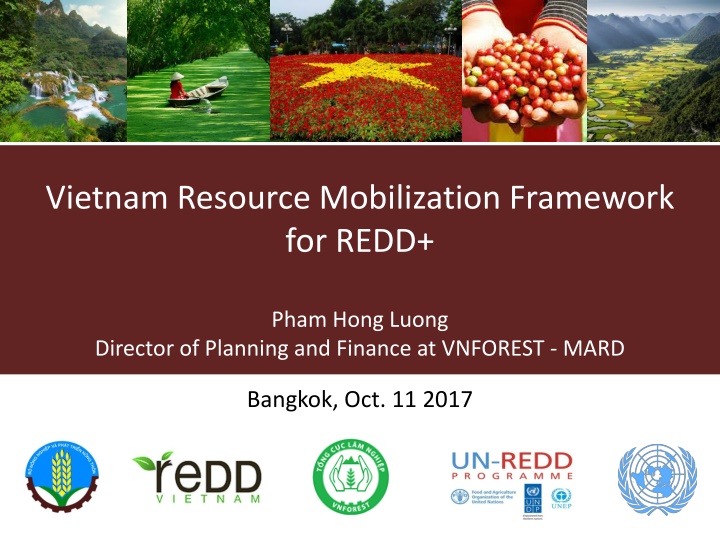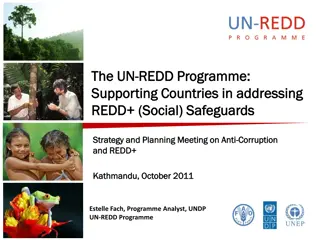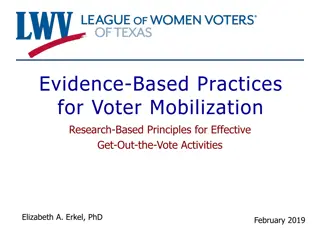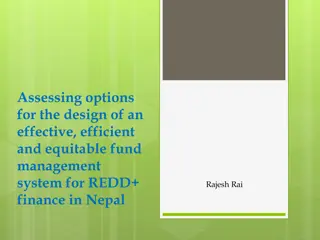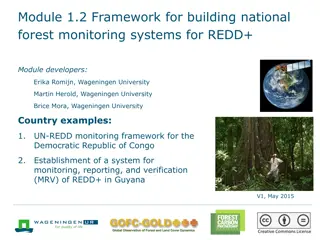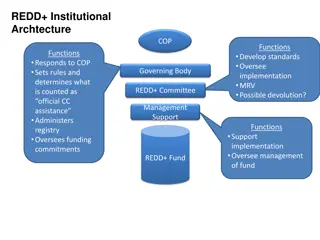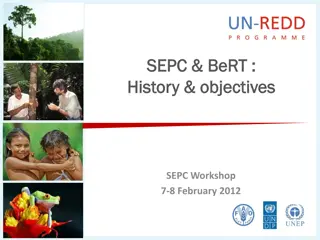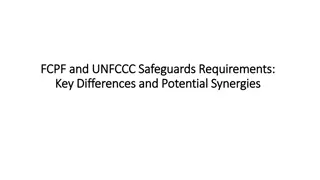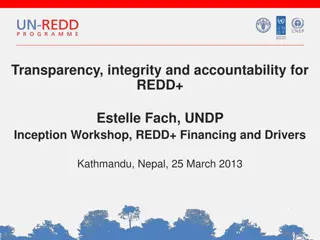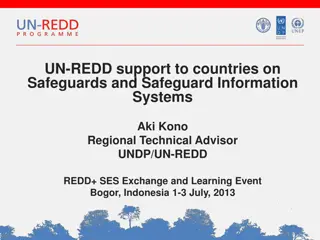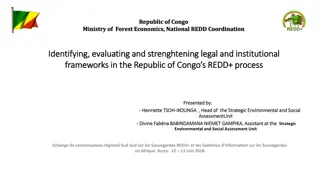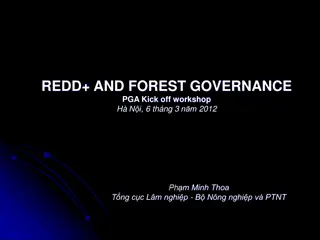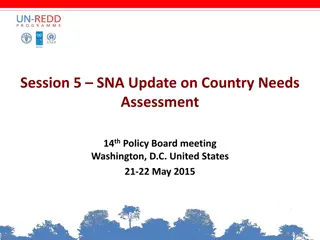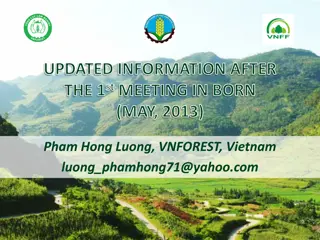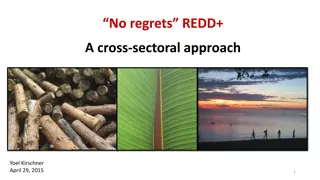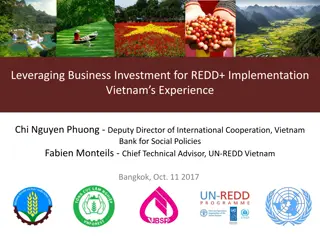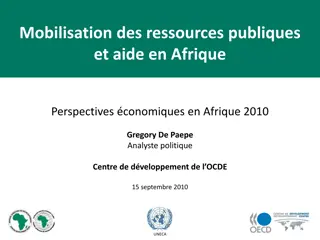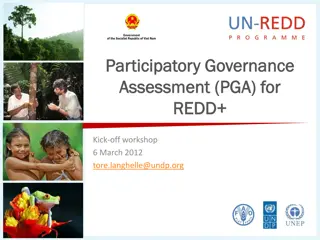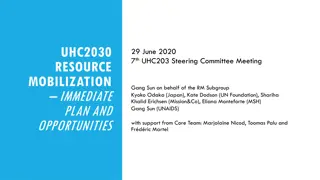Vietnam Resource Mobilization Framework for REDD+
The financial resources and mechanisms in Vietnam's forestry sector for REDD+ implementation. Learn about funding sources, financial gaps, key objectives, and scoping questions to support sustainable forest management and climate change mitigation.
Download Presentation

Please find below an Image/Link to download the presentation.
The content on the website is provided AS IS for your information and personal use only. It may not be sold, licensed, or shared on other websites without obtaining consent from the author.If you encounter any issues during the download, it is possible that the publisher has removed the file from their server.
You are allowed to download the files provided on this website for personal or commercial use, subject to the condition that they are used lawfully. All files are the property of their respective owners.
The content on the website is provided AS IS for your information and personal use only. It may not be sold, licensed, or shared on other websites without obtaining consent from the author.
E N D
Presentation Transcript
Vietnam Resource Mobilization Framework for REDD+ Pham Hong Luong Director of Planning and Finance at VNFOREST - MARD Bangkok, Oct. 11 2017
Current status 1 State budget 2 Private sector investments National financial resources Loans, concession credits, entrusted funds, cooperation and partnership funds 3 FINANCIAL RESOURCES FOR THE FORESTRY SECTOR PFES, forest environmental lease, afforestation alternative after conversion of forest resources 4 1 Official Development Assistant (ODA) and INGO Inter- national financial resources 2 Foreign Direct Investment (FDI) Payments for REDD+, selling of carbon credits/ CDM based on voluntary carbon markets 3 New financial commitments for addressing climate change (FCPF, GCF, CF) 4
Some new financial mechanisms in forestry sector Payment for Forest Environmental Services (PFES): Decree 99/2010/ND-CP, Decree 147/2016/ND-CP 1 Forest Environment Lease: 2 Decree No. 117/2010/ND-CP, Decision No. 24/2012/QD-TTg Offset replanting mechanism: 3 Decree No. 23/2006/ND-CP, Circular No. 24/2013/TT-BNNPTNT Payments for REDD+/Selling carbon credits: Decision No. 1775/2012/QD-TTg, Decision No. 799/2012/QD-TTg, 4 Decision No. 419/2017/QD-TTg Green Credit in Forestry: 5 Decree No. 55/2015/ND-CP, Decree No. 210/2013/ND-CP, Decree No. 75/2015/ND-CP, Directive No. 03/2015/NHNN
Objectives and content 4 key objectives - Identify and consolidate existing resources - Identify the financing gaps for NRAP implementation - Promote dialogue to bridge the gap with relevant stakeholders - Support management and coordination of REDD+ implementation through many financing sources Table of content - Executive summary - Introduction: context, methodology - NRIP finance secured - Financial gaps, barriers and opportunities - Strategy and action plan - Monitoring and evaluation
Key scoping questions - - - - Timeframe? (2017-2020, total and detail per year) Investments (vs. current expenditure, with blur lines) Approved programmes only (not yet approved = opportunities) Source of funding: - Domestic public finance (starting with the comprehensive Medium-Term Public Investment Plan 2016-2020) - ODA - Private finance Main challenges - Executive summary - Introduction: context, methodology - NRIP finance secured - Financial gaps, barriers and opportunities - Strategy and action plan - Monitoring and evaluation
Challenges faced in Vietnam - Scattered information and need to access information on funding sources at project level in relevant sectors to assess what really contributes to NRAP implementation A comprehensive view on ODA also requires long process of data collection Little history of collaboration and transparency with private sector Dissociating what is confirmed finance, and what is unsecured target quoted in cascading policy documents Information sources are not always reliable, some contradict each other or overlap and could lead to double-counting (particularly with ODA) Secured finance are not always fully relevant to REDD+, or follow approaches and methodology that partially meet REDD+ needs - - - - -
Solutions to address main challenges - Access to data: need to build collaborative approach with various sectors, and with the private and financial sector etc. Set consistent methodology to cross-check information sources and handle dataset at consistent level of details Collaborate not only for data collection, but also for data analysis and exploring opportunities for bridging gaps (align ) - -
Illustration 1: Mapping financial flow Coordinated initiatives for mapping land-use/REDD+ financial flows at national level (UN-REDD) and for Central Highlands region (EU-EFI). Challenges: echoing the broader issues (scattered data, lack of details, private sector data ) Critical steps: scoping, building typologies, collecting and analyzing data Further development: harmonize classification of typologies with other tracking initiatives (CPEIR ), and set system for labeling and quick/recurring monitoring of REDD+ finance
Resource mobilization strategy (first draft) Over-arching strategy: Strengthen Vietnam REDD+ Office s capacity to advocate, leverage, monitor and coordinate finance in three main directions: 1. Harness political leadership to align domestic public finance and policies with REDD+ objectives and implementation. 2. Attract international REDD+ finance through positioning, fundraising and coordination / alignment efforts 3. Build stronger partnerships with the private and financial sector. Building on new arrangements (intersectoral National Steering Committee chaired by Deputy-Prime Minister, required annual reporting from sectors ) Turned into a detailed work plan integrated to the Implementation Plan (staffing, organization, com., dialogue, networking, accountability ) Start from what you control. Vietnam taking an ambitious approach to pilot and replicate environmental fiscal and financial instruments
Illustration 2: public instruments - National Target Programme on Sustainable Forest Development (June 2017) to direct and guide State budget Direct and guide domestic and foreign direct investments from the private sector through regulation Opportunities associated with innovative environmental fiscal and financial instruments - - Payment for Forest Environmental Services Piloted in 2008, scaled up since 2011, Expanded in 2017 US$60M annually Expected $100M from 2017 on Covers 42% of national forests (5.9Mha) More than 500.000 beneficiaries, with approx. 100$ annual payment in average Pilots to improve forest impacts (joint REDD+ local fund, local revolving fund ) Offset replanting mechanism Since 2013: 68.200ha eligible; 40.600ha replanted; fees collected approx. $45M Forest environmental lease Piloted in some national parks. Example: Son Doong cave marketed by Oxalis; $660 per visitor paid to NP REDD+ payments UN-REDD Phase 2: $12M to province/local level activities ER-Programme to be assessed by FCPF CF board in Dec. 2017 ($48M programme) Green credit in forestry, green bonds, domestic carbon market
Current challenges 1/2 1. Revenue generated is lower than potential, mainly from 3 types of users; 2. Level of payment is different amongst watersheds; 3. Level of payment is still low, not adequate to offset labor invested; 4. Payment remission is slow, delays in payments still occur; 5. Monitoring and evaluation (M&E) of the FES quality is still limited. PFES 1. Reforestation progress is slow; money generated from forest re-plantation after conversion of forest resources has not been fully disbursed; 2. Regulations on management and use of money generated from conversion of forest resources is not clear; 3. Level of PFES payment is different, not meeting the requirement for restoration; 4. The value of forest ecosystems has not been calculated sufficiently. Offset replanting 1. REDD+ requires higher level of forest governance; 2. Opportunity cost for REDD+ implementation is high; 3. Conditions for payments have not been sufficiently secured; 4. Financial commitments are unclear; 5. Forest use tenure and forest carbon rights are still unclear. REDD+
Current challenges 2/2 1. Inventory and valuation of forest environment services requires substantial resources; 2. Procedures for forest environmental lease is complicated (requiring proposals, preparation of projects and options); 3. Rental price for forest environmental lease has not been specified; price framework not yet completely defined; 4. Controlling and assessment of environmental impacts is still limited. Forest Environ- mental Lease 1. Forest owners live in remote and mountainous area, with limited educational level; 2. The access of financial resources is limited (lack of support services); 3. Procedures to apply for loans are complicated (requiring ensured assets, mortgages); 4. Performance of forest protection depends on natural conditions, facing high risks; 5. Production cycle is long (5 to as many as 15 years); Green Credits
